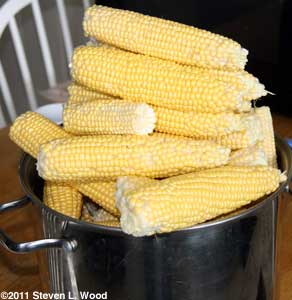One of the Joys of Maturity |
|
| Affiliated Advertisers |
Clicking through one of our banner ads or some of our text links and making a purchase will produce a small commission for us from the sale. The Old Guy's Garden Record
Saturday, July 2, 2011 - The July Garden We're going into the month of July with our main garden plots in very good shape. Our plants are lush, healthy, and currently have good soil moisture. Our East Garden is coming along, although we're facing some tough weed and critter problems there. One of the realities we face with gardening in west central Indiana is that our soil moisture situation will soon worsen. Sometime after the Fourth of July, we usually get into a mini-drought period that lasts through August and really makes gardening tough. Plants that are already established and have been mulched seem to do fairly well through the dry period, but getting new direct seedings started becomes a really iffy proposition. Our well won't support a lot of watering, which is one of the reasons I'm a bit freaky about heavily mulching our plantings. The hot days of July will mark the end our harvest of spring peas, lettuce, and broccoli, but they also bring on bountiful harvests of onions, carrots, and green beans. We will get our first tomatoes of the season this month, and possibly some sweet corn, cantaloupe, and watermelon. Part of the joy of gardening is savoring each crop as its season comes in. We've already enjoyed and frozen some peas, beets, and broccoli, and had a meal or two of new potatoes. But this month we'll begin storing, canning and freezing in earnest. We'll have garlic, onions, butternut squash, and possibly some potatoes to store in our basement "plant room." We hope our carrots will store as well in the refrigerator this winter as they did last winter. Green beans and whole tomatoes will be canned for winter use. And if we can keep the deer and raccoons out of the sweet corn, we should have enough of that to freeze as well. As crops are harvested, we'll add compost and/or fertilizer to renew the soil before planting new crops for fall harvest. Last year, a new soft bed and our asparagus patch got almost all of the compost we produced. This summer we should have compost available to side dress plantings. Garlic Harvest Complete
I occasionally will braid some of the garlic to dry. I usually do the braiding when the stems have dried and softened just a bit, but well before they are totally dry. I run a string through the braid to add strength to the braid and to facilitate hanging. At left is a braid from last year. (The braid I did today turned out way too ugly to display here!) Our back porch gets plenty of ventilation, essential for drying garlic and onions, but it also gets some sun, which isn't all that great for drying bulbs. The dogs and cats seem to not mind the garlic imposing on their area. The yellow cat carefully steps in between the garlic stems when crossing the porch. But he also likes to lie on the leaves at times.
Note that I still use sterilized potting soil when transplanting plants this young. Their tender stems can still be attacked by damping off fungus which is present in most potting soils. I started out with some potting soil that had been heated for an hour in a 400o F oven, but it quickly ran out. I did a quick, but somewhat less effective, sterilization of some more potting soil by pouring boiling water over it, putting the lid on the large kettle we use for sterile potting soil, and letting it sit for a few minutes. The freshly transplanted brassicas went onto the back porch to grow and harden off. The leftover starts went back under the plantlights in the basement as insurance in case some of the transplants don't take. Tunnels and mounds around our yard and in our raised bed garden plots reminded me today that it was time to make another application of Milky Spore Note: I've tried the burning mole bombs, poison peanuts, and mole traps, but Milky Spore has proved to be our best deterrent to mole damage in the garden.
I wound up taking just two or three feet (four to six foot row because of the double rows) of carrots out this morning before I hit some rather immature carrots and decided to call it a day on carrot digging. (It was also getting very hot, very quickly!)
After trimming (and some sampling), we brought in just over two pounds of beautiful carrots today. That brings us up to about five and a half pounds of carrots dug so far with lots more to come. The first dug carrots will probably go into our fall batch of Portuguese Kale Soup, with the later harvests being stored in the fridge. We were fortunate to be able to store carrots from last summer all winter in our refrigerator in some of those green bags
Growing carrots, onions, and sometimes lettuce, beets, and other veggies in an intensive gardening plot is really a lot of fun and something to me that is aesthetically pleasing. I love to see the canopy of onion and carrot greens accented by flowers at the ends of their rows. When I first tried intensive gardening plots with closely spaced vegetables, I was amazed at how well the plants produced in the close spacing. After discovering the glories of grass clipping mulch to suppress weed growth and softbeds, I became sold on intensive gardening for some of our crops. Softbeds are narrow raised beds, with or without timbers to hold in soil, that one works only from the side, never stepping into the bed. I don't think I've put a foot into the bed shown in the diagram below since I tilled it this spring! Keeping my weight off the bed helps keep the soil loose and friable. Note that I still like to grow things like green beans and kale in traditional, long rows with wide spaces in between rows to make picking easier. Our garden plan for this year for our onions and carrots worked out pretty well. I say pretty well as I usually am able to somehow squeeze in some beets in the intensive bed. That just didn't work out this year, so the beets went into another intensive planting bed with onions and lettuce. Our carrot harvest so far has been excellent. The onions growing on either side of the carrots are bulbing nicely, with some of the greens naturally bending over as they mature. As long as a storm doesn't prematurely knock over the onion stalks, we should have an excellent onion harvest later this month. The softbed at the other end of our main raised garden plot has also been productive so far this year, with excellent lettuce and some good beets. Because of the way I planted adjoining crops, I've frequently had to step into this bed to weed, harvest, and replant. I keep "walking boards" in this area almost all the time to help spread my weight a bit and prevent soil compaction. Our beets were supposed to go in a double row from transplants, but our tray of beet transplants got stirred a bit while hardening off on the porch. I ended up going with just a single row of beets from the transplants that survived, filling in with some direct seeded beets in bare spots where transplants failed. Since my son-in-law, Hutch, and I are the only ones regularly dining at our house who like beets, we got more than enough for fresh use and freezing. When the beets and first planting of lettuce were out of the softbed, I used the last of the lettuce starts I still had on the porch to plant a single row of late lettuce last month. Some of it bolted almost immediately, but it appears we're going to also get a few loose heads of lettuce from the second planting. Once the really hot weather of summer sets in, I don't even try growing heat tolerant varieties of lettuce, preferring to just wait until fall when lettuce again thrives in sunny, but cooler conditions. I probably won't do a posting here tomorrow, so let me wish you now a safe and enjoyable Fourth of July.
Thursday, July 7, 2011 - Fall Planting Help
For southern growers, the newsletter suggests that "July through September is the best time to plant warm-weather vegetables including beans, cucumbers, eggplant, peppers, summer squash, and tomatoes. Herbs such as basil, cilantro, and dill are also good choices for fall production. Pumpkins and watermelons can be planted beginning in August in north Florida and into September further south." Johnny's Fall Planting Calculator (358K) is a dandy, free spreadsheet that allows one to enter their fall frost date and then displays when fall crops should be planted each crop outside. It also shows which crops should be direct seeded and which should be started early and then transplanted on the recommended date(s). Plantings for fall harvest in the Senior Garden are generally limited to fall brassicas (broccoli, cabbage, and cauliflower), lettuce, and spinach. I started our brassicas indoors late last month in flower pots and transplanted them to fourpacks and moved them outside last weekend. It's just about time here to seed our fall lettuce (indoors). Harvesting Broccoli, Sugar Snaps, and Yellow Squash
One thing I have been carefully looking for this week on our yellow squash plants is any sign of damage from squash bugs. I found a cluster of squash bug eggs that had been laid on one of the leaves last weekend. I dispatched the eggs, but didn't find any squash bugs. I did find one immature squash bug today, but there were no more eggs and no signs of insect damage as yet. We had lots of damage from squash bugs last year in our yellow squash and our pumpkins. I'll continue to watch and wait, hand pick the bugs and remove eggs, but will probably have to resort to a pesticide at some point to protect our plants. Bed Renovation
The renovated bed will get some paprika peppers, flowers, and possibly some herb plants I still have transplants for. Flowers
Inside, we continue to rotate the gloxinias in bloom from under our plantlights in the basement up into our west facing kitchen window. We currently have a purple Double Brocade and a red to pink Cranberry Tiger in the window. I use empty coffee cans to raise the plants up to the window level so they can get adequate sunlight.
The green beans were great, although they were heavy on the "green" and light on the "bean," as it was an early picking. But after waiting almost a year for fresh green beans, I couldn't help but don my best SPF 50+ sun resistant clothing and bring in a couple of quarts of beans. This morning I was able to cut just a few small broccoli sideshoots, pick sugar snaps, shell peas, and a couple yellow squash, and take our garden and kitchen waste out to the compost heap before the sun came up over the treeline to our east. On the way to our East Garden, I spooked two deer, one that was browsing our sweet potato vines and another that was making a mess of our sweet corn patch (that is now tasseling and silking just a bit). When I came in from my morning gardening fun at around 7:00 A.M., it was already 86o.
Although I could squeeze in all of our gloxinia plants on two shelves, the plant stems were weak and a bit floppy when I'd try to move them. Giving the plants a bit more growing room and better lighting should improve the legginess issue (too tall with weak stems). I actually made the shopping harder for myself by hunting lighting units still made in this country. Alas, I don't think anyone in the United States still makes shop lights...at any cost. Even though my new units were branded American Fluorescent, the tiny print on the carton proclaimed "Made in China." I do like that the units will take either the T8 or T12 size fluorescent tubes, as I still have a lot of T12 tubes in stock.
One thing struck me as I stood in the bed of my pickup truck snapping pictures of the field. This was really an ugly looking field of asparagus! Maybe that's just the way large fields of asparagus look, but I was surprised at its appearance compared to our manicured, small raised bed of asparagus at home. With a heat index of 115o F as I write, the shingles will stay on the truck until after sundown. About the only good news in that is that we just might get a good thundershower out of the heat and humidity yet today. Yes, I did get a year older since my last posting here. And I was supposed to get help in blowing out all those candles, too! Wednesday, July 13, 2011 - Green Beans
Picking our beans was a bit difficult, as the six inch wide row of beans planted had spread to about three feet wide. I crawled down one side on my knees while picking, as I had kale on my left and beans on my right. The pepper plants on the other side allowed a bit more room for picking there. I was pleased to find only slight insect damage to our beans today. Only a few beans had to be discarded due to bug damage. So at this point, I still won't have to spray for insect control. When we can beans, we usually follow the directions in our old Ball Blue Book
I've tried putting our snapdragons where they're more visible in our garden. Sadly, they don't stand up too well to the strong winds that sweep across the adjacent field into our garden, so I plant them along our trellises to give them support. Rainfall
Despite the drying conditions, our main raised garden bed still is looking pretty good. Sunday, July 17, 2011 - At the Zoo We have lots going on in our garden, but I just haven't had time to write. Yesterday, I had Simon & Garfunkel's At The Zoo Monday, July 18, 2011 - Carrots, Again! Today's big gardening task was either going to be taking out our broccoli plants or digging the last of our carrots. Our broccoli sideshoots are now beginning to bolt before I can get them picked, but since our carrots were due and overdue to be dug, they got the nod.
Today's effort reminded me that it's a good idea to get carrots out before the soil dries down in mid-summer. I used just a thin trowel to lift our carrots out earlier, but today I had to resort to using our garden fork to get under the carrots and break the dry, heavy soil. There were very few small carrots today, but there were a couple that were trying to go to seed, along with about a dozen with split and deformed roots, probably due to the growing carrot root hitting a stone in the soil. But most of the carrots were good sized without blemishes. I didn't weigh today's take, but there sure were a lot of carrots to wash, trim, and wash again before storing them in the refrigerator. I also gave our Frontier customer service technician a pound or so, as he was laboring in the heat to install a new phone box and our DSL connection. Our onions on either side of our carrots are tipping over now and beginning to dry down. I brought in one Walla Walla sweet onion that was ready today and mixed it with carrots, sugar snap peas, green beans, garlic, and yellow squash from our garden for a steamed delicacy for our supper tonight. Tuesday, July 19, 2011 - Heat Index - 114o F at 2 P.M. When it's this hot outside, I'm often reminded of Robin Williams' humorous Adrian Cronauer/Roosevelt E. Roosevelt weather report from the movie, Good Morning, Vietnam Today is one of those days where it would have been wise to garden early...very early in the day to avoid the worst of the heat. Unfortunately, I was chasing supplies in Terre Haute this morning and staying out of our house that I was fumigating for fleas. We love our pets, but our annual onslaught of fleas isn't much fun. Like most of the central United States, there's not much relief in sight. We have a slight chance of rain over the weekend or on Monday, and the mercury may drop just below 90 towards the first of next week. While we don't irrigate our garden plots due to our weak well, I will be doing rescue waterings (with buckets) where I think I might be losing a plant.
I know this sounds like a crazy old miser washing paper plates and plastic flatware, but recycling the plant labels saves me a few bucks and also makes me feel okay about using lots of labels where I find it necessary. Once the labels are thoroughly rinsed and dried, I store them in an old, plastic peanut butter jar. The labels are available through Twilley Seeds for a fairly reasonable $9.90/200. So...tomorrow's another day, the good Lord willing, and I'll try to get out early and get some gardening done.
After picking beans, I got to a chore that I'd put off for several days, clearing out our spring broccoli plants. Our broccoli had succumbed to the heat with sideshoot heads blooming almost as soon as they set on. I was able to twist most of the shallow rooted broccoli out of the ground today. I then used a corn knife to trim the leaves for our compost pile. Heavy stems went into a hole someone dug that I'm filling in with yard trash. I've found that thick broccoli stems don't decompose well in our compost heap. They take well over a year to break down.
Where Our Beautiful Sunsets Come From A front page article that appeared in today's Terre Haute Tribune-Star, Indiana 6th in toxic air pollution, had a second headline in the print edition on the page it was continued to, "Merom closest coal-fired plant to Vigo on list." Vigo refers to Vigo County where Terre Haute is located. Merom refers to the power plant whose chimney we can see from our back porch when the trees aren't leafed out! We live in a Bermuda Triangle of air pollution, with Hoosier Energy's Merom Generating Station just a mile or so away. Ten or twelve miles southwest of us is the Marathon Oil Refinery in Robinson, Illinois. And the Ameren's Hutsonville Power Station is just eight or nine miles west of us, although the station only comes online these days in peak use periods. Needless to say, we have beautiful sunsets...and we use lots of lime on our ground. Sunday, July 24, 2011 - Rain!!!!
We'd had most of our onions tip over naturally a week or so ago. I pulled the storage onions yesterday and let them just sit in the garden until today when I transferred them to our back porch for final curing. Later, one of my grandsons, Brady, pulled the sweet onions while I rubbed dirt off the bulbs and put them in our garden cart. One of the great things about growing ones own onions is that they're pretty much ready to use at any growth stage. One can take scallions early on for salads, and bulbs as soon as they've formed a bit. We use the sweet onions that don't store well over the winter for summer dishes, pulling them as needed, especially where we've crowded the onions in the row a bit. As we have way more sweet onions than we can use before they spoil, some will get chopped and frozen for use this winter. Others will go to family members.
We switched from Wild Blue and Dish to Frontier High Speed Internet and Direct TV. When I called to cancel our service with Dish, it turned out that there were all kinds of savings to be had. It's too bad the rep some months ago wasn't willing to play fair. So the old dishes are on the ground awaiting their return. We have somewhat faster and far more reliable internet service for a fraction of what satellite internet cost. And we'll see how the Direct TV part of the bundle works out. (We can't get their dish installed until after we lay new shingles on the porch roof.) We're still working out a few kinks on the Frontier High Speed Internet, however. We got just half the speed we ordered, and I had an unproductive talk with their customer service about it on Friday. In frustration, I emailed the regional president a bit after the close of business Friday afternoon and got a return email and later a call saying things would be fixed next week. As I was writing up this posting at the end of an eventful day, a lovely sunset appeared. Wednesday, July 27, 2011 - Melons Coming On
Since the Sugar Cubes are our first cantaloupe/muskmelons to ripen fruit, it will be interesting to see how long they produce. Our hill of Sugar Cubes last year ripened a lot of fruit early, but then continued to produce well into the fall, despite some really dry conditions. Our Passport honeydew melons have now ripened (and we've picked) all the fruit they'd set! We have one Tam Dew, a new honeydew variety we're trying for the first time this year, still ripening, but I haven't seen any other honeydew in the mixed Passport/Tam Dew hill. With a bit of rain, both varieties should begin to bloom and set fruit again soon, as the vines are still in good shape.
When I went out to hunt a Sugar Cube melon this evening, I noticed that our row of nasturtiums (above left) may survive. While the geraniums and marigolds in the row weathered our mini-drought, I thought the nasties were goners. But I noticed them leafing out again this evening. We're sorta holding our breath and hoping that the critters don't find our melons and sweet corn before we get the corn in and begin harvesting melons in earnest. Deer bit off the tops of many of our corn plants, but it appears we may still get several dozen ears from the planting. Last year, the deer and raccoons took almost all of our sweet corn. I'd resolved then to put up a hot wire this year, but backed off due to the cost of electric fencing.
Annie gave me a package of Sweeney's All Season Weatherproof Deer Repellent I've also been spreading the contents of our vacuum cleaner around the garden, along with some blood meal. The sweepings idea came from a friend who used to grow a certain cash crop in very remote locations and swore it would keep the deer away. At this point, I'm willing to give it a try (the sweepings, not the cash crop). Tomatoes We're just beginning to get some small tomatoes from our Moira tomato plants in the East Garden. Our grape tomato plants in the main garden area are also beginning to ripen. But our Better Boy and Bella Rosa tomatoes in the main garden, our main crop tomatoes, are all still green. Green Beans
While it was tough finding good beans to pick today, the picking was pretty easy, other than the heat. For our last pickings of beans, I just pull the plants and pick the beans off of them before putting the vines in our garden cart. It saves a lot of stoop labor.
Interestingly, our sweet potatoes don't seem to mind the lousy soil in the East Garden. Last year was the first time we've done much with sweet potatoes. Since I had the space this year, I put in a long row of sweet potatoes. I'm sure come fall when I have to dig sweet potatoes from that heavy clay soil, I'll wonder what I was thinking in planting so many. Internet Service I mentioned in my last posting that we were still working out some kinks in our new, "high speed" internet connection. After several unsuccessful calls to tech support and customer "service" at Frontier Communications, I finally got ahold of someone who could get things moving. We're now getting what we subscribed for and will be paying for. It's too bad I had to go to the regional president of Frontier to get things fixed. Crop Rotation We've enjoyed having the visual backdrop to our main garden this year of the best field of corn I've seen so far in our area. I'm sure some of the credit goes to the skill of the farmer, but I also know that the field had been in soybeans the two previous years. I'd guess that may have a lot to do with the gorgeous field of corn. Saturday, July 30, 2011 - Gully Washer Our dry spell broke last night with a real gully washer for an hour or so, followed by a steady soaking overnight rain. We got well over an inch of rain here, but just a few miles south of us, they only got a couple tenths of an inch. I dug a bit in the garden this morningand was pleased to find our soil moist six to eight inches deep in the garden.
When you finally get the bulk of your onions bagged and stored, it becomes apparent what did well and what didn't. We have tons of Walla Wall sweet onions this year. They don't store well, but can be chopped and frozen. Our Pulsar, Milestone, and Red Zeppelin storage onions produced okay crops, certainly enough for our use over the next year. I cheated last winter and used some year old stored seed, even though I know onion seed doesn't freeze well. I'll obviously go with fresh onion seed next December or January when I seed our onion starts for next year. BLTs It has become a bit of a tradition for us to have bacon, lettuce, and tomato sandwiches when we harvest our first, really ripe, full size tomato. My wife, Annie, picked a bunch of ripe Moira tomatoes in our East Garden Wednesday evening, so it was BLTs for supper on Thursday. Moira tomatoes have a deep red interior when ripe, and Annie selected a perfectly ripe one to slice. I managed to find some good ears of corn in our weedy corn patch to go with our sandwiches and some green beans leftover from earlier in the week, but there's nothing quite like that first tomato of the season. Sweet Corn Annie and I went out to pick in the East Garden this afternoon. While there weren't any perfect tomatoes, we found two Sugar Cube melons and two Athena melons that were ripe. The real surprise of the picking was how much sweet corn was ready to pick. Our sweet corn patch had been ravaged earlier by deer eating off the tops of the corn plants and later became partially overgrown with weeds when I focused my attention elsewhere in the East Garden.
As I was cutting corn off the cob, I noticed how pretty our current star of the kitchen counter was. We rotate gloxinias from under the plantlights in the basement into the kitchen, and the current purple Cranberry Tiger is just loaded with blooms.
From the
at Senior Gardening |
©2011 Senior-Gardening.com

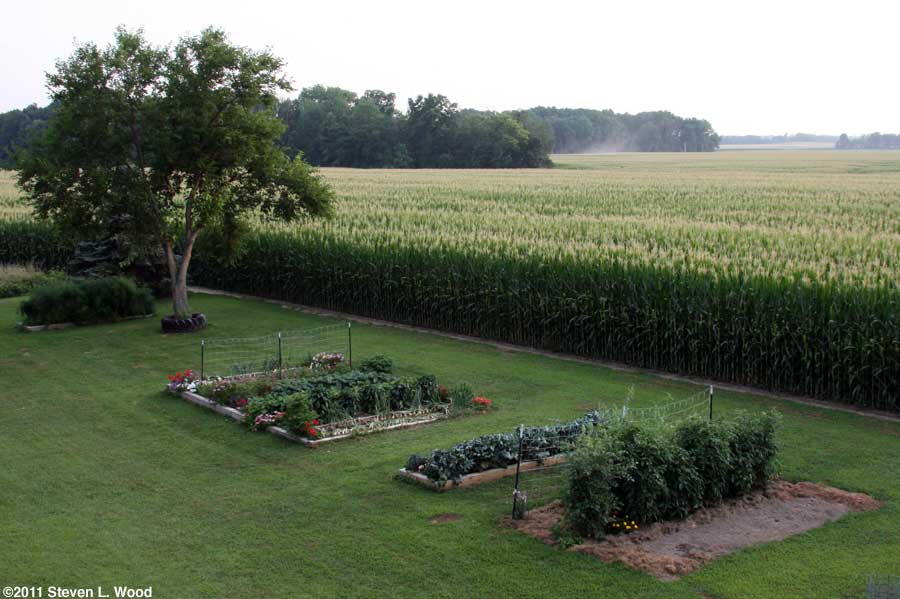






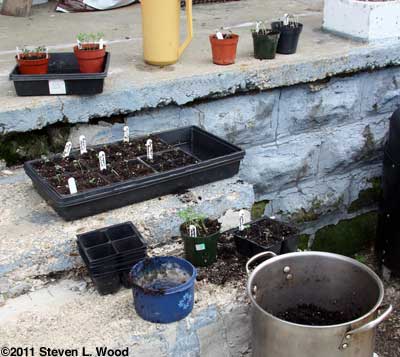








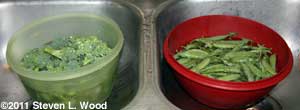

















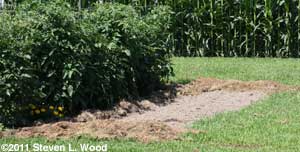






 Thursday, July 21, 2011 - Odd Thoughts While Waiting for the Pressure Canner to Cool
Thursday, July 21, 2011 - Odd Thoughts While Waiting for the Pressure Canner to Cool 







 Our porch repair project forced me to get busy on something I should have pursued months ago. Our satellite and TV dishes were located on the roof to be repaired, so they both had to come off. Some time ago I'd called Dish to question some items on our bill (such as the "free" high def they advertised, but still charged us for). I spoke then to a very rude customer service rep who sealed Dish's fate in doing business with us that day.
Our porch repair project forced me to get busy on something I should have pursued months ago. Our satellite and TV dishes were located on the roof to be repaired, so they both had to come off. Some time ago I'd called Dish to question some items on our bill (such as the "free" high def they advertised, but still charged us for). I spoke then to a very rude customer service rep who sealed Dish's fate in doing business with us that day.












